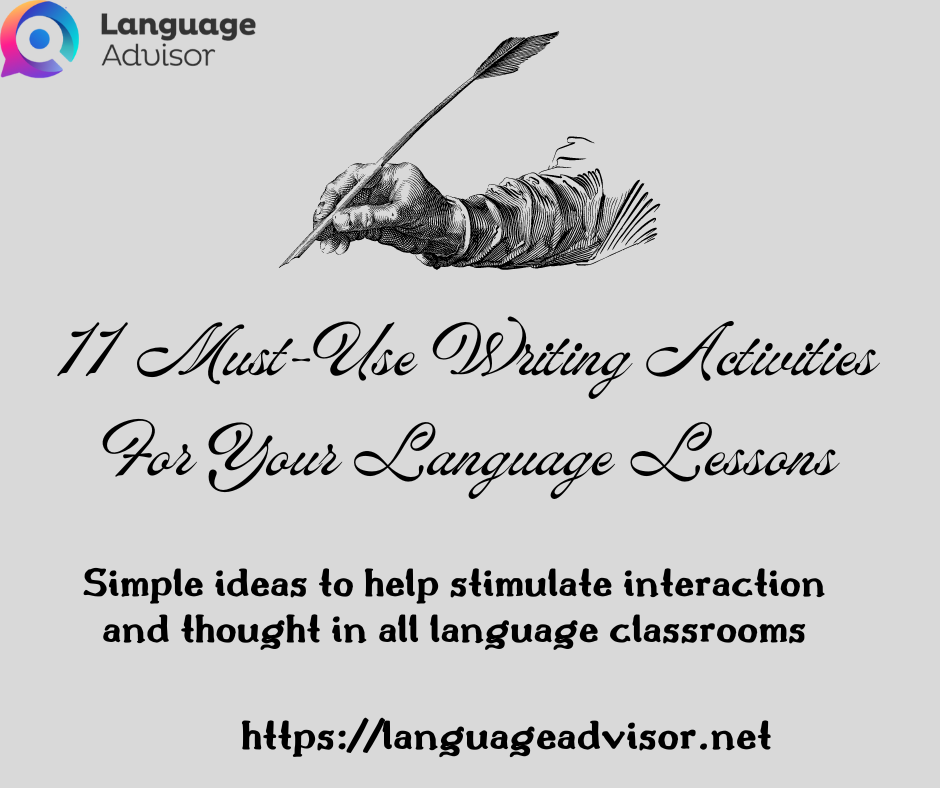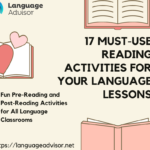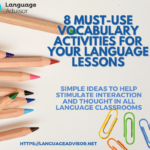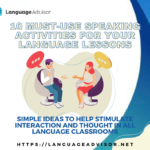11 Must-Use Writing Activities For Your Language Lessons. Simple ideas to help stimulate interaction and thought in all language classrooms
11 Must-Use Writing Activities For Your Language Lessons

11 Must-Use Writing Activities For Your Language Lessons. Fun Writing Activities for All Language Classrooms
11 Must-Use Writing Activities For Your Language Lessons
A list of 11 Must-Use Writing Activities For Your Language Lessons to keep your students engaged.
Writing activities can come in many different forms. For a communicative teacher, writing activities often represent a chance for students to finally show off their learning and respond to the material presented in class. Thus, writing activities are windows into a learners’ mind, giving teachers a chance to assess what students know and think (focus on meaning), as well is how well they are performing (focus on form). These two paradigms, focusing on meaning and form, fundamentally change the kinds of activities teachers create when assigning writing activities.
Those who focus on meaning are generally interested in how well their learners communicate their own ideas, and often spend time creating activities that give learners time to generate, germinate, and expand ideas. On the other hand, for the “focus on form” teacher, writing activities can represent opportunities for learners to follow particular linguistic principles. These teachers often create activities that elicit the proper use of writing conventions or grammatical rules. The activities presented here can be used for both paradigms, and often, with just a little imagination, can be used and modified in ways that can simultaneously accomplish a teacher’s requirements to pay attention to both meaning and form.
Notice that many of these activities require a teacher to think of a prompt in order to be successful. A prompt can be a question, a statement, or even a picture or object that students must respond to. Writing is often enhanced by the teacher’s ability to inspire students to want to write, which can be achieved with the quality and interest level of the prompts teachers create.
When focusing on meaning, ask questions that are all based on a similar theme. This will activate background information. For example, if the class will be talking about the beaches of Hawaii for their next lesson, try to ask 4-8 questions that will encourage students to think about Hawaii (animals, people, food, places).
When focusing on form, ask questions that will allow learners to respond to that form. For example, when teaching the past tense, ask learners to describe what they did last week, last year, over the summer, and so forth.
What we learn with pleasure we never forget.
~
Alfred Mercier

11 Must-Use Writing Activities For Your Language Lessons
What follows are a few very simple ideas to help stimulate interaction and thought in an classroom.

Workstations
Description
Place four to eight large sheets of poster size paper on the walls of the room, leaving enough room for learners to form groups.
On each paper is a question or prompt that students must answer. Questions might be personal or impersonal, based on a reading or lecture, or even based on a grammatical principle you want learners to demonstrate.
When you create these “workstations,” you might want to set up some rules. For example, you might way to require each student to write one sentence at each station, or move in groups to a new station every five minutes. For convenience, you might have students write at their desk first on small sticky notes, and then have them transfer their notes to the posters. Upon finishing the activity, you might ask students to read each thought and star the ones they like best, or you might correct any mistakes or emphasize the vocabulary shared. This is a great activity to get students moving and generating ideas.


Freewrites
Description
Freewriting is a technique in which students write continuously for a set period of time without regard to spelling, grammar, or topic. Some writers use the technique to collect initial thoughts and ideas on a topic, often as a preliminary draft to more formal writing. A freewrite means that students are “free” to write whatever they want, but often you must guide the free-write with a prompt.


Fast-writes
Description
A fast-write is similar to a freewrite because spelling, grammar, and vocabulary are not evaluated. However, what is evaluated is the number of words written in a given time. Students can gain a sense of accomplishment as they see their writing speed increase. They are generally given an easy topic to fast-write about, and sometimes a teacher will discuss the prompt ahead of time and elicit vocabulary words on the board before the learners begins. For a fast-write to be accurate, a teacher must ensure that the activity is done the same way every time.


Brainstorming
Description
Brainstorming is an informal way of generating topics to write about. It can be done at any time during the writing process. Writers can brainstorm the topics for a whole paper or for just a conclusion or an example. The important point about brainstorming is that there should be no pressure to be “brilliant.” Students should simply open their minds to whatever pops into them. Think of it as a kind of free association. For example, with an advanced group discussing poverty and education, teachers might say something like, “When I say ‘literacy,’ what pops into your mind?”
Much of what the students will come up with may not be useful, but that’s okay.
Part of brainstorming will involve a selection process. A teacher might write students’ ideas on the board, or invite a student to write down the ideas. Ateacher can also rephrase questions or add to questions to help students to respond more fully. For example, a teacher might ask, “Is literacy important?
Why?” or “What do you think is stopping literacy today?”
Afterwards, the teacher might go back to the question: “What else pops into your mind when I say literacy?” As a general rule, when brainstorming with a classroom, expect silence and expect the need for the teacher to follow up with questions. Teachers may also need to call on individuals, or invite students to speak in pairs and groups before sharing in front of the class.
Here is an example of brainstorming



Venn Diagrams
Description
A simple Venn diagram looks like two circles intersecting, and is often used as a pre-writing or post-writing activity. Venn diagrams are used to compare and contrast two subjects, objects, people, and so forth. For example, if a class wanted to compare dolphins to sharks, students would place the similar items inside the parts of the circles that intersect (fins, swim, eat fish), and put items that are unique to dolphins (mammals, play with humans) and sharks (sharpteeth, dangerous) in each non-intersecting area.
Here is an example of Venn-diagram



Unfinished Stories
Description
Invite students to finish a story or article. This can help them to predict the actual ending, and can also serve to have them imitate the tone and vocabulary of the reading. This activity can be done in groups or individually.


Any Four Pictures Make a Story
Description
This activity requires students to think creatively and make connections. It can also be a lot of fun to see how students’ imaginations differ.
To do this activity, place any four random pictures on a wall (or on a handout). If placing the pictures on the wall, make sure that they are printed large enough for all the students to see. Then have students try to make a story based on those four pictures. Since the pictures are unrelated, the stories the learners generate are usually rather original.Teachers may want to help learners before they begin doing this activity by writing down vocabulary words that they do not know (invite them to ask questions about each picture to generate this list). Other requirements, such as the length of the story and the grammatical elements to be included, should be specified.


Guesswork Dictation
Description
In this activity teachers will ask students to write down a few sentences that have been created, as in a normal dictation. In this dictation activity, however, replace key words with “impossibly big words” in place of key vocabulary. Have the students write out the dictation. For the large words, tell the students that it is okay to guess the spelling.
Examples:
(1) Macroseisms happen in Arizona all the time. (earthquakes) – English
(2) Rechtsschutzversicherungsgesellschaften – German
(3) Les longs lapins las lançaient lentement les lourds légumes laids le lendemain lorsque les légères Latino-Américaines libérales labellisaient lamentablement les lâches livreurs Lyonnais. – French
(4) Para la a más palabras hay, astral afán, acabará más cansada la chancha. – Spanish
(5) Sopra la panca la capra campa, sotto la panca la capra crepa. – Italian.
Share the sentences out loud just like a normal dictation, and allow each student to write down what he or she hears. After, invite students to guess the meaning of the “impossible” word. Students often can remember key vocabulary better when they see a similar, more difficult word, and often enjoy the sound and complexity of larger words.


Remember the Picture
Description
Bring a picture that would be interesting for students to look at. Use a picture with a lot of detail, such as a picture with a lot of people on the beach doing different activities.
Handouts can be made for each student or large pictures that can be seen from the front of the class can be used (teachers can even draw their own). Have students study the picture for one minute. Then remove the picture from their sight and have them write as much as they can remember. Students can be encouraged to focus on verbs or nouns, colors or shapes, or whatever language focus is being studied at the time.


Draw Your Neighborhood
Description
Have students draw their own neighborhoods. Then have students share stories about their neighborhoods. They might want to discuss a time when they had a fight, their first crush, or other interesting stories.


Poetry Writing
Description
Often students are intrigued by different forms of poetry. Teachers can use haiku, limericks, sonnets, and other forms to create engaging writing assignments. One way to inspire learners to write in a foreign language is to ask them to produce poetry using poetry templates. A poetry template can help a learner with various kinds of language tasks, and can help to motivate learners to share their lives and opinions.

11 Must-Use Writing Activities For Your Language Lessons
Here are some other writing activities you can find on Language Advisor
Writing Activities For Your Language Lessons











